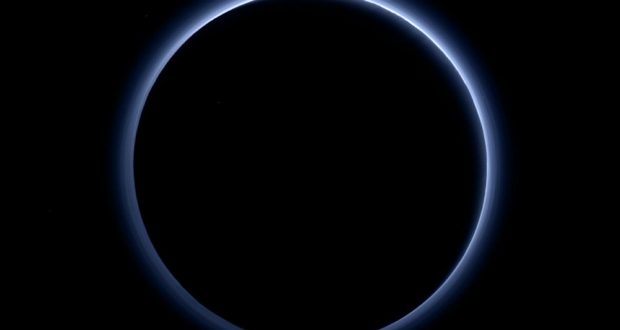Pluto has blue skies and exposed, bright red water ice, Nasa announced on Thursday, as the first spacecraft ever sent to the dwarf planet continues to send data from the edge of the solar system.
Nasa’s New Horizons probe sent the first color images of Pluto’s atmospheric hazes to Earth last week, revealing that the mysterious mix of particles scatter blue light when sunlight reaches them.
“Who would have expected a blue sky in the Kuiper belt? It’s gorgeous,” Alan Stern, the mission’s principal investigator said in a statement. New Horizons is now venturing farther into the Kuiper belt, a region of dwarf planets and ancient debris that rings the solar system’s farthest edge.
Pluto’s haze consists of particles called tholins, solid, unusual molecules that are sometimes compared to tar or soot for the way they react and recombine with other molecules. In this case, Nasa researchers believe the tholins form high above the surface, where sunlight ionizes the nitrogen and methane that makes up most of the dwarf planet’s atmosphere.
“All those haze layers are actual layers in pluto’s atmosphere stretching up literally more than 100 miles,” Stern told the University of Alberta on Monday.
On Earth, the sky looks blue because sunlight scatters when it strikes the tiny nitrogen molecules that dominate the atmosphere. “On Pluto they appear to be larger, but still relatively small,” said science team researcher Carly Howett in the statement. The researchers noted that the molecules – each likely red or grey – condense and fall down to Pluto’s surface, gathering ice frost on the descent and eventually adding to the world’s reddish tint.
In contrast to its Earth, Mars has smudged dawns and bleary sunsets, sometimes in a grey-green or mix of yellow and hazy blue. Its atmosphere is 95% carbon dioxide, and far thinner, although the Curiosity rover has from time to time photographed blue clouds drifting through the dust. In contrast the Venusian atmosphere, although also mostly carbon dioxide, churns with clouds of sulfuric acid created in part by the extreme radiation so close to the sun.
Nasa also announced the discovery of exposed regions of water ice, curiously at some of the places that appear bright red in recent color images.
 Blog For Noob Random thought of a Noob Blogger
Blog For Noob Random thought of a Noob Blogger









